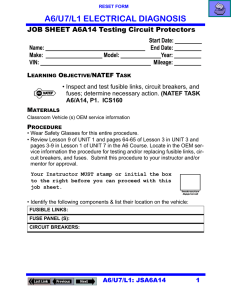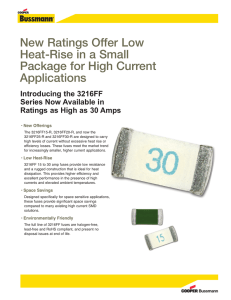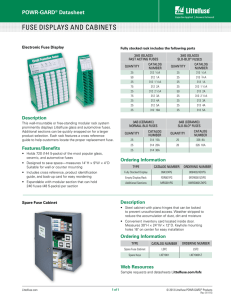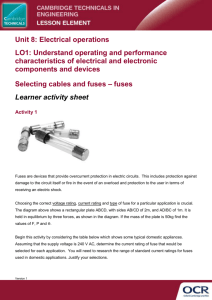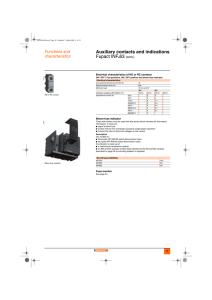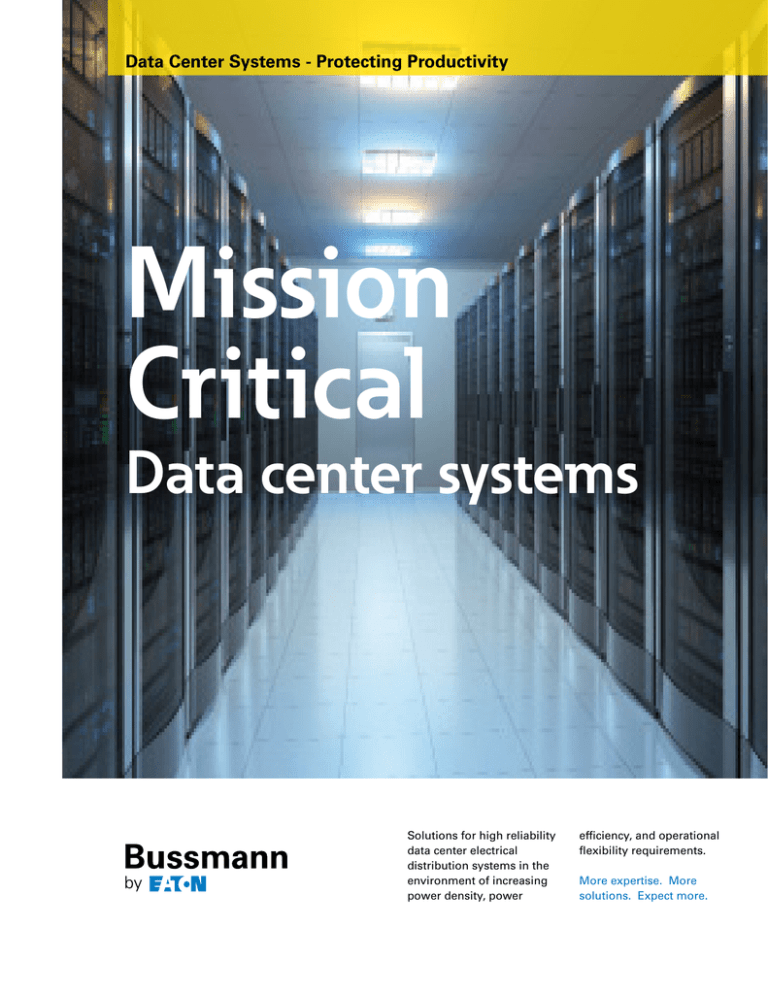
Data Center Systems - Protecting Productivity
Mission
Critical
Data center systems
Solutions for high reliability
data center electrical
distribution systems in the
environment of increasing
power density, power
efficiency, and operational
flexibility requirements.
More expertise. More
solutions. Expect more.
Mission Critical Data Center Systems
Data Center
Mission Critical/Data Center Electrical Distribution
Systems
Data center electrical distribution designs are rapidly evolving, driven by needs such as
increasing power densities, energy efficiency, more flexibility for making changes after
the initial install, increased uptime, adhering to safe electrical work practices, and
minimizing maintenance while retaining reliability. Many of these design advances result
in higher distribution voltages, high available fault currents, and greater potential arc
flash hazard. Current-limiting fuses provide excellent overcurrent protection for the
challenging needs of modern data centers. The following section will discuss some of
these trends and challenges facing designers and users along with the solutions that
current-limiting fuses can provide. This section will discuss:
1. Products for data center overcurrent protection
2. Fusible solutions for two broad architectures: PDU architecture and busway
architecture
3. Highlight the benefits of fusible data center distribution systems
4. Trend to higher distribution voltages
1. Data Center Distribution Architectures
PDU Architecture:
See Figure 1 for power distribution unit (PDU) architecture. The line side of the UPS
system can consist of a normal source and alternate source utilizing standard fusible
power distribution panels or fusible switchboards. PDU manufacturers are now
incorporating the new Bussmann Quik-Spec™ Coordination Panelboard (QSCP) in their
PDU and RPP (remote power panel) offerings. The new QSCP panelboard utilizes the
innovative 600Vac rated Compact Circuit Protector (15A to 100A) integrated with the 1 to
100A UL Class CF CUBEFuse. The width of the standard enclosed QSCP panelboard
for general construction branch panels is the same as standard 20” circuit breaker
panelboards. The single pole Compact Circuit Protector (CCP) with CUBEFuse is 1” wide
and is available in one, two, or three pole versions. At the cabinet, a fusible rack PDU
provides another level of current-limiting fuse protection. Fusible solutions offer many
benefits which will be discussed later in this section.
Fusible Switchboard
or Power Panel
PDU or RPP with
Fusible Panelboard
Fusible Cabinet
Distribution Unit
Static Switch
Branch 2
UPS
SC
Fuses
Fusible panelboard utilizing the Bussmann
CCPB Disconnect with CUBEFuses
Available 1 to 100A
Rack PDU Fuses for
Branch 1 and 2
Branch 1
with LPJ-SP, LPS-RK_SP,
KRP_C_SP Fuses
1/10 to 6000A
Figure 1. The fusible solution PDU architecture utilizes standard available fusible distribution panels/switchboards, PDUs/RPPs with the new QSCP panelboards incorporating the CCP
disconnects and CUBEFuse, and rack PDU systems with fuse protection.
2
©2014 Eaton
Mission Critical Data Center Systems
Data Center
Busway Architecture:
See Figure 2 for busway architecture which utilizes a plug-in busway to distribute power
on the loadside of the UPS to the cabinets. The plug-in busway is suspended above
server cabinets. The bus plug-in unit can utilize the 30A, 60A, or 100A Compact Circuit
Protector integrated with 1 to 100A CUBEFuse. The fusible bus plug-in unit is attached to
the rack PDU via cable. At the cabinet, a fusible rack PDU provides another level of
current-limiting fuse protection. The fusible solution offers many benefits which will be
discussed later in this section.
Fusible Switchboard
or Power Panel
With bus plug-in units utilizing the CCP disconnect and CUBEFuse, the plug-in unit does
not have to be changed out for ampacity changes to rack, if proper foresight and work
practices are followed. Instead the disconnect can be switched to off. Then the
CUBEFuse can be changed to the amp rating that is necessary for the cabinet or server
change. See the discussion under Data Center Products.
Fusible panelboard utilizing the
Bussmann CCP Disconnect
with CUBEFuses
Available 1 to 100A
Plug-in Busway
Fusible Panelboard
Static Switch
Fusible Cabinet
Distribution Unit
UPS
SC
Fuses
Rack PDU Fuses for
Branch 1 and 2
Branch 1
with LPJ-SP, LPS-RK_SP,
KRP_C_SP Fuses
1/10 to 6000A
Branch 2
with LPJ-SP, LPS-RK_SP,
KRP_C_SP Fuses
1/10 to 6000A
Figure 2. The fusible solution plug-in busway architecture utilizes standard available fusible distribution panels/switchboards, fusible bus plug-in units incorporating the CCP/CUBEFuse
fusible disconnects, and fusible rack PDU systems.
2. Trend to Higher Distribution Voltage
The majority of the installed data center distribution systems are 208/120Vac. However, there is a major trend to utilizing higher electrical distribution voltages with the most prominent
being 415/240Vac and with some 480/277Vac and 600/347Vac.
Figure 3. 208/120Vac and 415/240Vac data center distribution centers. In the 208V system the PDU includes the transformer. In the 415V system configuration, the 415V is
transformed from a higher voltage prior to the data center and as a result there are no transformers in the data center. For either system the circuits to the cabinets could be from a
panelboard or busway with plug-in fusible disconnect.
©2014 Eaton
3
Mission Critical Data Center Systems
Data Center
See the 208/120Vac 3 phase system example in Figure 3. The three phase UPS output
supplies a transformer from which the downstream distribution can be via a PDU
architecture or busway architecture. With the PDU architecture, the transformer PDU
may distribute 208V to a number of other panels (referred to as remote power panels or
RPP) located throughout the data center which then distributes power to rack PDUs at
the server cabinets. The cabinet power supplies are connected to the rack PDU.
See the 415/240Vac 3 phase system example in Figure 3. Industry experts have found
that data center distribution at higher voltage can increase energy efficiency and
reliability within a data center. There are many ways to configure 415Vac data center
electrical systems. This 415Vac example illustrates a “transformerless” data center,
where the transformation to 415Vac from a higher voltage is outside the data center.
Moving to 415/240Vac data centers accommodates the typically available cabinet power
supplies. The typical cabinet power supplies operate within a voltage range of 200Vac to
240Vac with some of the lower wattage power supplies operating within a voltage range
of 100 VAC to 240 Vac. Commonly, 415/240Vac three phase is brought to the rack PDU
and the rack PDU distributes single phase 240Vac to the cabinet power supplies. This is
a significant advantage since higher efficiency is achieved while using existing power
supplies.
The drivers moving to 415Vac data centers include increased mean time between
failure (MTBF), double the power to the rack in the same footprint, double the power for
a given conductor size, and reduction in components with a result of less space
utilization and lower cost. However, there is the resulting increase in voltage and
available short-circuit currents. It is important to consider the OCPD type, ratings, and
characteristic best suited to meet the desired design criteria and the operational
practices while complying with the NEC and OSHA.
3. Benefits of Fusible Designs
Current-limiting fuses offer many benefits to the data center designer and owners. These
advantages are more pronounced with the challenges posed by the trend to higher
voltage, higher energy efficiency and greater power density data centers. As a
consequence, the overcurrent protective devices in the PDUs, RPPs, busway plug-in
units, and cabinet rack PDU must have higher interrupting ratings at higher voltage
ratings. In addition, this electrical equipment must also have higher short-circuit current
ratings.
With higher fault currents, ensuring selective coordination becomes even more essential
to avoid cascading overcurrent protective devices causing unnecessary outages.
Similarly, higher fault currents typically result in higher arc flash incident energy unless
mitigated by current-limiting overcurrent protective devices.
Interrupting Rating:
Interrupting rating is the maximum short-circuit current that an overcurrent protective
device can safely interrupt under standard test conditions. IR is an abbreviation for the
term interrupting rating. Interrupting capacity with an abbreviation of IC is an older
synonymous term carried over from years past. The National Electrical Code, UL
Standards, and markings on fuses and circuit breakers now use the term interrupting
rating and markings such as "IR 200KA" or "200kA IR." The term AIC or KAIC, such as
in "200k AIC," is no longer used for product markings nor in the NEC or UL Standards.
All overcurrent protective devices must have interrupting ratings equal to or greater than
the available fault current at their lineside terminals per NEC 110.9 and OSHA
1910.303(b)(4). In addition to fault currents trending up in new data centers, existing data
centers can be expanded, increasing fault current beyond the interrupting ratings of
existing OCPDs. Current-limiting fuses typically have interrupting ratings of 100,000A,
200,000A or 300,000A for 600Vac or less. With higher voltage distribution to the cabinet
(i.e., 415Vac or greater), it is not uncommon to have 50kA or greater short circuit current
available at a RPP or server cabinet busway plug-in unit. Even the cabinet power
distribution unit can have high fault currents. Therefore, the 5kA IR or 10kA IR
overcurrent protective devices often used in rack PDUs may be inadequate for many
installations.
Circuit breaker solutions for higher available short-circuit currents either (a) use fully
rated circuit breakers (each circuit breaker has an individual interrupting rating equal or
greater than the available fault current at its lineside terminals) or (b) use series
combination rated circuit breakers (a circuit breaker is permitted to have an interrupting
rating less than the available fault current at its lineside terminals if installed in a
panelboard that is tested, listed, and marked with a specific line side circuit breaker or
4
fuse). Fully rated circuit breakers with higher interrupting ratings cost more and may have
a larger footprint. In either case with fully rated or series rated circuit breaker systems,
achieving selective coordination is usually more difficult to achieve when using standard
molded case circuit breakers; this is more pronounced as the fault currents increase.
Fuses inherently provide fully rated high interrupting ratings for systems with fault
currents up to 200kA without any price premium or footprint increase. The high
interrupting rated fuses are all current-limiting making it simple to achieve selective
coordination and easy to provide excellent protection of circuit components.
Component Protection and Short-Circuit Current
Rating of Equipment:
One of the principal advantages to fusing data center circuits is the current-limiting ability
of fuses which can greatly reduce the let-through energy during faults. Per the fuse
product standard UL 248, current-limiting fuses are not permitted to exceed maximum
allowable energy let-through values under fault conditions. This provides excellent
protection for components. The most current-limiting fuses (UL fuse Classes CF, J, RK1,
T, CC, G, and L) provide superior short-circuit current protection. All equipment and
components in the data center electrical system are required per NEC 110.10 and OSHA
1910.303(b)(5) to have a short-circuit current rating equal to or greater than the available
short-circuit current. This includes the transfer switches, UPSs, PDUs, RPPs, busway,
bus plug-in units, rack PDUs, and power supplies. The trend is that systems are capable
of delivering more fault current as a result of the higher voltage and higher power density
designs being used in data centers.
A current limiting device is needed to quickly drive the short-circuit current down to zero
and keep the let-through energy below the damage levels of the equipment.
For instance, most fusible panelboards and enclosed disconnects can be tested, listed,
and marked with a 200,000A short-circuit current rating. If busway is tested, listed, and
labeled with current-limiting fuses as the short-circuit protection, 200,000A short-circuit
current rating is typically achievable.
Selective Coordination:
The ability of a system to prevent an unnecessary blackout, has been a design
consideration in data centers and mission critical systems long before it was a code
requirement in the NEC® for systems supplying life safety loads. Mission critical system
designers understand the added reliability that selective coordination of overcurrent
protective devices brings to systems. The 2014 NEC® 645.27 requires the overcurrent
protective devices in critical operations data systems to be selectively coordinated.
The use of properly selected fuses in data centers alleviates the design hassle of trying
to achieve selectively coordinated overcurrent protective devices at the cabinet and
busway (or PDU) levels as well as further upstream. Fuses simply need to maintain a
2:1* amp rating ratio for Bussmann Low-Peak fuses from the lineside fuse to the loadside fuse in order to achieve selective coordination. This eliminates the possibility of
cascading multiple levels of overcurrent protective devices under fault conditions.
When overcurrent protective devices are not selectively coordinated multiple levels of
overcurrent protective devices can cascade open on a fault condition. An example of a
non selectively coordinated system: a fault in a power supply or rack PDUs results not
only in one of the rack PDU overcurrent protective devices opening as it should, but the
RPP or busway plug-in overcurrent protective device opens unnecessarily resulting in the
unnecessary power outage to the entire rack PDU. Even worse is if the feeder
overcurrent protective device would open for a fault in the rack PDU resulting in an
unnecessary power outage to an entire PDU/RPP or busway run.
See the clarifying Note under the section Fusible Cabinet Power Distribution Unit for
selective coordination on 415/240V systems between SC 20A fuse to CUBEFuse 40A or
larger.
*Where fuses are in same case size the 2:1 ratio may not apply, consult Bussmann.
Reliability:
Fuse operation is based on a simple thermal principle; the internal fuse element will
rapidly melt, at a very specific level of energy. Users can be assured that a fuse’s precise
thermal element will always operate when called upon to remove a fault and protect
valuable equipment. It’s a matter of physics. The internal parts of modern current-limiting
fuses do not require maintenance. Periodic checking fuse bodies, fuse mountings,
adjacent conductor terminations for signs of overheating, poor connections, or insufficient
conductor ampacities is important. As a result, the ongoing maintenance costs of fusible
systems are typically less.
©2014 Eaton
Mission Critical Data Center Systems
Data Center
Renewability:
OSHA 1910.334(b)(2) is the law when an overcurrent protective device opens due to an
overcurrent. If an overload caused the opening, then fuses can be replaced or circuit
breakers reset. However, if a faulted circuit caused the opening, then fuses cannot be
replaced or circuit breakers reset “until it has been determined that the equipment and
circuit can be safely energized.” To avoid possible catastrophic damage to equipment or
danger for workers, it is important to identify the source of the fault and repair the faulted
circuit. In addition, the conductors and electrical components on the faulted circuit path
should be tested and verified suitable to be placed back in service. When a fuse opens
an overcurrent, it is replaced with a new factory calibrated fuse and the same level of
protection is assured.
Safe Work Practices
See Figure 4. CUBEFuses can be serviced without removing the deadfront to a
PDU/RPP or accessing the interior of a plug-in busway enclosure. CCPB/CUBEFuses
are IP 20, finger-safe when installed in a panelboard/RPP with deadfront construction as
shown in Figure 8 and CCP/CUBEFuses are IP 20, finger-safe when installed in plug-in
busway enclosures as shown in Figure 12. In the event of a fuse opening, simply open
the door of the panelboard to view the CCPB/CUBEFuses or merely look at the plug-in
busway exterior to view the CCP/CUBEFuses. The open fuse(s) will be identified by
either the open fuse indicating light on the CCPB or CCP (circuit must be closed for
indication light to illuminate) or the optional indicator on the CUBEFuse. The CCPB
disconnect is interlocked with the CUBEFuse. When extracting or inserting a CUBEFuse,
place the CCPB disconnect handle in the “OFF” position.
Flexibility
There are data center operation flexibility and inventory advantages for some
applications with the CCP/CUBEFuse. These are described in the next section Compact
Circuit Protector and CUBEFuse.
4. Data Center Products
Compact Circuit Protector and CUBEFuse™ (CCP/TCF):
The innovative CUBEFuse™ with 300kA interrupting rating is available in amp ratings
from 1A to 100A. These fuses have been on the market for more than a decade and
offer many advantages including smallest footprint and finger-safe. The CUBEFuse is
available in a time-delay version (TCF) which has a 600Vac/300Vdc rating and
fast-acting version (non-time-delay) (FCF) which has a 600Vac/600Vdc rating. See
Figure 5. Both CUBEFuse versions are very current-limiting, resulting in excellent
equipment short-circuit current protection and arc flash incident energy mitigation. The
TCF is available in an on-board indicating version and a non-indicating version. The FCF
is available in a non-indicating version.
100A, 60A, & 30A TCF - with and without
optional indication
100A, 60A, & 30A FCF - non-indicating
Figure 5. CUBEFuse™ TCF and FCF versions
Deadfront
Open fuse
indication light
Optional open fuse
indication
Figure 4. Servicing fuses is easy with equipment using Compact Circuit Protectors with
CUBEFuses.
Arc Flash Mitigation:
Arc Flash is a frequent concern in today’s data centers. With minimizing downtime as a
priority, it is important to have current-limiting overcurrent protective devices mitigating
the arc flash hazard where possible. By limiting the energy let-through and quickly
bringing the current down to zero, fuses can reduce the arc flash hazard experienced
during most arc flash events.
In addition, arc flash hazard mitigation is dependent on the “design and condition of
maintenance” of the overcurrent protective device per 2012 NFPA 70E 130.5. If
overcurrent protective devices that require maintenance are not maintained, an actual
arc flash event can be more severe than that determined by the arc flash hazard
analysis. 2012 NFPA 70E 205.4 requires overcurrent protective devices to be
maintained and the “maintenance, tests, and inspections to be documented.” Fuses are
inherently reliable for fault conditions. There is no need to maintain the internal parts of
fuses. All that is necessary is to maintain the external connections and proper
environmental conditions.
View showing blades
For datacenter applications, the CUBEFuse in conjunction with the Compact Circuit
Protector, which is a small UL 98 fused disconnect, offer great advantages. The amp
ratings of the Compact Circuit Protector range up through 100A. This combination of
Compact Circuit Protector disconnect and CUBEFuse provides excellent overcurrent
protection solutions. The Quik-Spec Coordination Panelboard (QSCP) incorporates the
Compact Circuit Protector/CUBEFuse and provides the means for fusible PDUs/RPPs.
For the busway data center architecture the Compact Circuit Protector with CUBEFuse™
is incorporated into busway plug-in units.
These products offer excellent switch/fuse combinations for data center applications.
There are two versions of the Compact Circuit Protector using the CUBEFuse™. See
Figure 6.
1. CCP: DIN-Rail mount version, which allows small fusible switch applications such as
the plug-in busway unit up to 100A.
2. CCPB: bolt mount version used in the QSCP panelboard, which allows fusible
panelboards having up to 100 amp rated branch circuits with panel width and depth
the same as traditional circuit breaker panelboards.
Bolt mounted 30A versions
©2014 Eaton
View showing blades
60A DIN-Rail version
Figure 6. Bolt mounted Compact Circuit Protector Base (CCPB) with non-indicating CUBEFuse,
and DIN-Rail mount Compact Circuit Protector with indicating CUBEFuse.
5
Mission Critical Data Center Systems
Data Center
A CCP or CCPB has a disconnect amp rating and horsepower rating. A CCP or CCPB of
a specific amp rating can accept any CUBEFuse amp rating equal or less than the CCP
or CCPB amp rating.
There is a notable difference in the bolt mounted version versus the DIN-Rail mount
version. The DIN-Rail mount version CCP disconnect is available in 30A, 60A, and 100A
ratings. So the 30A CCP will accept 1A to 30A CUBEFuse. The CCP 60A will accept the
1A to 60A CUBEFuse and the CCP 100A will accept the 1A to 100A CUBEFuse. The
bolt-on CCPB is available in the NEC® standard branch circuit amp ratings of 15, 20, 30,
40, 50, 60, 70, 90, and 100 amperes. Each bolt mounted CCPB will accept any
CUBEFuse amp rating equal or less than the CCPB amp rating.
This feature of a given Compact Circuit Protector accepting CUBEFuse amp ratings
equal or less than its amp rating provides some important flexibility options for data
center management. For instance, if a plug-in busway unit uses a CCP 60A and the
cable whip is rated 60A, then any CUBEFuse from 1A to 60A can be installed.
For example, assume on the initial installation, a 15A CUBEFuse is needed so a 15A
CUBEFuse is inserted in the plug-in busway unit CCP. Then modifications are required to
the cabinet changing the load so that a 35A CUBEFuse is needed. All that is necessary
is to switch the 60A CCP disconnect to “off,” remove the 15A CUBEFuses and insert the
35A CUBEFuses. Then switch the CCP to “on.” This can save time and reduce inventory
of busway plug-in units since the entire plug-in busway unit does not have to be removed
and replaced with a larger amp rating unit.
1-pole version
2-pole version
Figure 9. Remote power panel incorporating chassis QSCP with CCPB/CUBEFuse.
Courtesy Eaton.
3-pole version
Figure 7. Both CCP and CCPB are available in 1-, 2-, or 3-pole versions. Shown are CCPs.
Quik-Spec Coordination Panelboard and PDU/RPP:
The Quik-Spec Coordination Panelboard (QSCP) is rated 600Vac and can be utilized for
either 208Vac or 415Vac data centers applications (or up to 600Vac). The left image of
Figure 8 shows the QSCP as a complete panelboard and the right image of Figure 8
shows a QSCP chassis or interior only version which other manufacturers integrate into
their PDU/RPP equipment. Examples of QSCP chassis versions in other manufacturers’
RPPs are shown in Figures 9, 10 and 11.
The complete panelboard version QSCP with high SCCR, 300kA IR CUBEFuses, ease in
achieving selective coordination, and excellent arc flash hazard mitigation is also an
excellent panelboard for electrical distribution system supplying non-IT equipment loads
in a data center such as the computer room air conditioners/air handlers (CRAC/CRAH).
RPP
Expanded view of
disconnects with
CUBEFuses
Figure 10. Remote power panel incorporating chassis QSCP with CCPB/CUBEFuse.
Courtesy Cyberex, Thomas & Betts Power Solutions.
Spare Fuses
Complete panelboard
version
Figure 8. Quik-Spec Coordination Panelboard (QSCP).
6
Chassis
version
Figure 11. Remote power panel incorporating chassis QSCP with CCPB/CUBEFuse as well as spare
CUBEFuses in holders. Courtesy Liebert® FDC™ power distribution cabinet from Emerson Network
Power™.
©2014 Eaton
Mission Critical Data Center Systems
Data Center
There are two alternatives in specifying CCPBs for PDUs/RPPs.
1. The CCPBs can be specified for the specific branch circuit amp ratings of 15A, 20A,
30A, 40A, 50A, 60A, 70A, 90A, or 100A. Each CCPB will accept CUBEFuse amp
ratings equal to or less than its respective ampere rating.
2. The CCPB can be specified all 30A, or 60A, or 100A or a mixture of these ampere
ratings. This approach allows for more flexibility and less inventory of CCPB
disconnects needed when circuit changes or PDU/RPP changes are made. For
instance, if all the CCPBs disconnects in an RPP are 60A, then CUBEFuses that may
be inserted in the 60A CCPB can range from 1 to 60A. With this alternative, if the
branch circuit conductors are changed to a different ampacity, the CCPB disconnect
does not have to be replaced, only the CUBEFuses with the appropriate amp rating
needs to be inserted in the CCPB. Similarly, if the RPP is moved, only the fuses have
to be changed to reconfigure for the circuits at the new location.
Fusible Rack Power Distribution Unit:
By using fuses in the rack PDU, the rack PDU IT and circuits can be properly protected
in systems even with high available fault levels. In addition, this scheme can isolate a
faulted subsection of the rack PDU, thereby keeping the power supplies fed by the
remainder of the energized rack PDU (when rack PDU fuses are selectively coordinated
with upstream RPP fuses or busway plug-in fuses see Note on Selective Coordination for
rack PDU below). See Figure 13. If a fault or overload were to occur on branch 1, the
branch 1 fuse would open and remove the overcurrent from the circuit. The rest of the
rack PDU would remain in normal operation. Rack PDU manufacturers provide options
for local and remote notification if a fuse opens. Remote notification includes both
SNMP traps (simple network management protocol traps) and email alerts.
CDU Fuses for
Branch 1 and 2
Branch 1
Branch 2
Plug-In Busway Fusible Disconnect:
A plug-in busway utilizing the DIN-Rail mount version CCP/CUBEFuse is suitable for any
voltage up to 600Vac. The cable whip connects the busway unit to the cabinet
distribution unit. See Figure 12.
Figure 13. Partial views of fused rack PDU or cabinet power distribution unit (CDU). SC fuses are
used in this rack PDU to protect the receptacles and circuit to the power supplies.
Courtesy of Server Technology, Inc.
Note on selective coordination for rack PDU fuses with upstream fuses: the easiest way
to achieve selective coordination with fuses is to adhere to the published Fuse Selectivity
Ratio Guide (see this section in SPD publication). 20 amp SC fuses are commonly used
in the rack PDU as shown in Figure 13. CUBEFuses, either TCF or FCF, are often used
in the supply circuit to the rack PDU via the RPP or busway plug-in disconnect. The
published selectivity ratio for a TCF fuse supplying a SC fuse is 4:1(for a 600 volt
system), which means for a rack PDU using a SC20 fuse the minimum upstream TCF
fuse would need to be 80 amps to ensure selective coordination. However, tests have
demonstrated that either TCF40 or FCF40 fuses (or larger) will selectively coordinate
with downstream SC 20 fuses for 415/240V systems up to 100,000 available short-circuit
amperes (the SC fuse interrupting rating). The deviation from the published ratio for
these specific type fuses and amp ratings is due to the characteristics of these specific
fuses being used at the lower application voltage of 415/240V.
Figure 12. StarLine® Track Busway fusible disconnects using the DIN-Rail mount CCP with
CUBEFuse.
Courtesy of Universal Electric Corporation (UEC).
©2014 Eaton
7
Customer Assistance
Customer Satisfaction Team
Application Engineering
Available to answer questions regarding Bussmann
products & services Monday-Friday, 7:00 a.m. – 6:00 p.m.
Central Time. Contact:
Technical assistance is available to all customers.
Application support is available Monday-Friday,
7:00 a.m. – 5:00 p.m. Central Time. Contact:
• Toll-free phone: 855-287-7626 (855-BUSSMANN)
• Toll-free phone: 855-287-7626 (855-BUSSMANN)
• Toll-free fax: 800-544-2570
• E-mail: fusetech@cooperindustries.com
• E-mail: busscustsat@cooperindustries.com
Emergency and After-Hours Orders
Next flight out or will call shipment for time-critical needs.
Customers pay only standard product price, rush freight
charges, & modest emergency service fee. Place these
orders through the Customer Satisfaction Team during
regular business hours. For after-hours, contact:
• After hours 314-995-1342
Online Resources
Visit www.cooperbussmann.com for the following
resources:
• Product search & cross-reference
• Product & technical materials
• Solutions centers for information on topical issues
including arc flash, selective coordination & short-circuit
current rating
• Technical tools, like our arc flash calculator
C3 – the Enhanced, Online Cooper Customer Center
• Where to purchase Bussmann product
Provides real time product availability, net pricing, order
status & shipment tracking for: B-Line, Bussmann,
Crouse-Hinds, Lighting, Power Systems & Wiring Devices.
Call 877-995-5955 for log-in assistance. Available at:
• www.cooperc3.com
Eaton’s Bussmann Business
PO Box 14460
St. Louis, MO 63178-44602
www.bussmann.com
Eaton
1000 Eaton Boulevard
Cleveland, OH 44122
United States
Eaton.com
© 2015 Eaton
All Rights Reserved
Printed in USA
Publication No. 10079
February 2015
Eaton is a registered trademark.
All other trademarks are property
of their respective owners.

